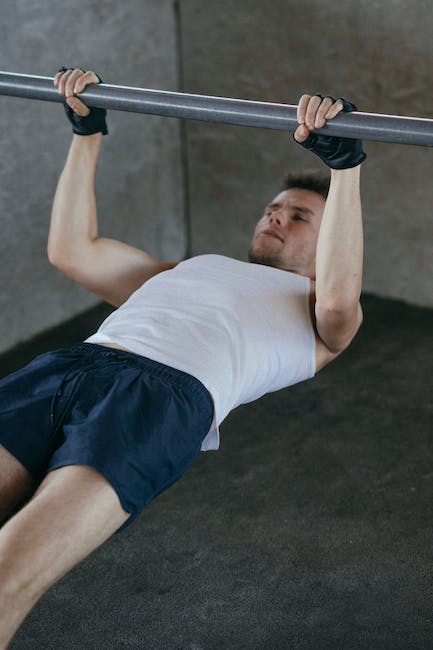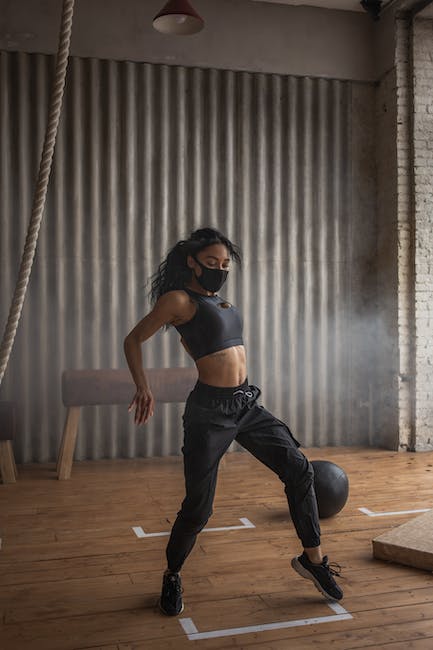
Push-Ups: The Basics of Fitness Training
If you’re looking for an easy way to get fit, the push-up could be your answer! Push-ups are one of the most basic, yet effective forms of fitness training. They’re a great way to build upper-body strength, improve your posture, and get the blood flowing. In this article, we’ll discuss the basics of push-up training so you can get started on your own fitness journey!
List of Content
- 1. What is a Push-up?
- 2. Benefits of Push-up Training
- 3. How to Perform a Basic Push-up
- 4. Making Push-ups Easier or Harder
- 5. Common Mistakes to Avoid When Doing Push-ups
- 6. Push-up Variations to Increase Your Workout Intensity
- You Ask, I answer

1. What is a Push-up?
A Push-up is a type of bodyweight exercise. This type of exercise is beneficial for developing strength, building muscle, and increasing overall fitness. To perform a push-up, you just need a flat surface to lie on, like the floor or a bench. Here is what a basic push-up looks and feels like:
- Start by lying facedown on the floor. Place your palms flat on the floor, directly beneath your shoulders.
- Engage your core muscles and press your palms into the floor as you lift your upper body off the ground. Your arms should be straight and your body should form a straight line from your shoulders to your heels.
- Lower your body back to the floor by bending your elbows. Keep your elbows tucked close to your body, creating a 90-degree angle with your upper arms and forearms.
- Press up to the starting position and repeat.
Push-ups are extremely versatile and can also be modified to target different muscles. For instance, widening the distance between your hands will target your chest muscles, while shifting your hands forward and lowering your body further will focus on your triceps.
With consistency and pushing yourself to increase the difficulty of each workout, push-ups can be an extremely beneficial exercise for improving your strength and overall fitness level.

2. Benefits of Push-up Training
Increased Strength Among the most significant is that it works for many of your body’s muscle groups. You’ll find that your chest muscles, anterior deltoids, triceps, and core are all strengthened with regular push-up practice.
Imperceptible Workouts Another unwavering attribute of push-up training is that you can do any of these exercises nearly everywhere and without requiring any equipment. Whether you’re at home, out in a field, or tucked away in the corner of an office, a quick set of push-ups will do the trick.
Increased Endurance One of the most important is that you can strengthen your body’s endurance. Doing regular, creative push-ups exercises brings great physical advantage as your body improves its capacity to do whatever the job needs it to do.
Improves Focus and Balance Perhaps one of the lesser known benefits is that push-up training can improve both focus and balance. The small shifts and adjustments during a push-up exercise need intent concentration and those moments of focus are crucial for getting in balance. Additionally, doing push-ups routinely can help you find the right balance between various exercise kinds.
3. How to Perform a Basic Push-up
Push-ups are a classic exercise that are great for building up your strength. Here’s how to get started with a basic push-up.
1. Get in Position
- Start by lying on the ground, face down.
- Come onto your hands and knees, and then straighten your arms. Position your hands slightly wider than shoulder-distance apart.
- Your feet should be together and your body should form a straight line from your head to your feet.
- Your head and neck should be in line with the rest of your spine; look slightly ahead of you.
2. Lower Your Upper Body
- Breathing in, slowly lower your upper body down to the ground. Keep your elbows at a 45 degree angle as you go down.
- Keep your back straight and your core muscles engaged.
- Lower until your chest is close to the ground. Make sure to keep your chin tucked in.
3. Push Back Up
- Exhale and push back up to the starting position. Keep your elbows at a 45 degree angle.
- Make sure to keep almost all of your weight on your hands throughout the exercise.
4. Making Push-ups Easier or Harder
Changing the Angle of Push-ups
If you want to make your push-ups easier, adjust the angle of your body. A flatter angle, with your body almost parallel to the ground, reduces the amount of weight you’re pushing against. Adjust the angle of your body by leaning your hands further up on a wall or keeping them at your sides on the ground.
You can also make the standard push-up more challenging by raising your feet on a raised surface or working on a wall for an incline. This places more of your weight in your arms and chest, and increases the difficulty of the exercise.
Vary Your Hand Position
Another way to adjust the difficulty of your push-ups is to change the position of your hands. Target different muscle groups by widening or narrowing your hands, or see how it feels to do the exercise with your hands close together or far apart.
For beginners, performing push-ups on your knees is a great way to start as it takes some of the bodyweight away. Once you feel more comfortable with the movement, you can gradually increase the difficulty level by standing on your toes.
Adding Resistance
You can also modify your push-ups by adding extra resistance. Use a resistance band, a weight vest, or a jumping rope as you perform the exercise.
You can also use an incline bench to increase the difficulty of your traditional push-ups. The elevated surface forces you to push harder than you normally would and builds additional strength.
Smaller Reps
If you’re able to do a certain number of push-ups without much difficulty, try reducing the number of reps. This forces your muscles to work for longer periods of time, which increases the intensity of the workout.
You can also try doing fewer traditional push-ups, but pausing at the bottom of the movement to increase your time under tension. Lower yourself in a controlled motion, pause for a few seconds, press back up, and repeat.
5. Common Mistakes to Avoid When Doing Push-ups
Form Is Key: Excellent form is essential when it comes to push-ups. If you’re slouching or arching your back, you’re defeating the purpose of the exercise and probably doing more harm than good. Make sure you’re on your toes, keeping your core tight, spine neutral, and head in line with the rest of your body.
Not Engaging Your Glutes: Engaging your glutes will improve the stability of your core, as well as allowing you to use more of your body weight in the exercise. Prioritizing glute engagement will make every rep a full-body workout, while also preventing you from arching in the lower back.
Uneven Shoulders: Uneven shoulders can lead to neck and back issues. Make sure your shoulders and hands are consistent. Keep your arms in, chest up, and core tight. You’ll be able to ensure they are properly aligned, and your shoulder blades will be stable during the exercise.
Going Too Fast: Rushing through your reps can increase your chance of injury. Taking your time ensures you maintain proper form and can get the most out of each rep. Aim for five seconds up, hold for three seconds, and five seconds to come down. Think about each movement and don’t be fooled by the simple appearance of the exercise.
6. Push-up Variations to Increase Your Workout Intensity
Reach for new heights with these six increased intensity push-up variations:
- The Decline Push-Up: Prop your feet up on an elevated surface and perform a regular push up.
- The Plyometric Push-up: As you push-up, explode into the air to create a clapping motion.
- The Uneven Push-Up: Place one hand on an elevated surface or on top of a medicine ball and perform a regular push-up.
- The Superman Push-up: Place your feet very close to each other and your hands on the ground. Perform a regular push-up then hold after you push-up and lift your legs off the ground while touching your feet.
- The Medicine Ball Push-Up: Place your hands on a medicine ball and perform a regular push-up.
- The Spiderman Push-up: As you go up from the push up, bring your left knee to your left elbow. Then go back to the regular push-up and repeat with your right knee to your right elbow.
Adding variety to your push-up workout can increase your intensity and make your workout more effective. Each of the push-up variations mentioned above can be just as challenging as a regular push-up while also engaging different muscle groups.
If you’re a beginner, start by slowly adding one variation into your daily push-up routine. Once you can confidently perform the variation with proper form, try adding a second variation to increase the intensity of your workout. Remember, challenge yourself but don’t compromise your form!
Proper form is essential not only to make sure your push-ups are most effective, but also to avoid injury. Be sure to keep your core tight, shoulders back, and your hands and feet shoulder width apart. Keep your arms straight and your body in a straight line, and aim to lower to the ground as close to 90 degrees as possible.
Mixing up your push-up routine with different push-up variations can help you to continue to progress and reach your fitness goals. As you get comfortable with each variation, you can increase the reps to take your workout to the next level. No matter what level you are at, the right push-up variation can help you to make the most of your workouts!
You Ask, I answer
Q: What is a push-up?
A: A push-up is an exercise that primarily works the chest, shoulder, and triceps muscles. It is performed by lying face down on the floor and pushing your body up with your arms, keeping the rest of your body straight.
Q: What muscles do push-ups target?
A: Push-ups primarily target the chest, shoulder, and triceps muscles. The core, glutes, and quadriceps are also recruited during this exercise.
Q: What are the benefits of doing push-ups?
A: Push-ups are a great full body exercise to help build strength and overall fitness. They are often used to help increase physical fitness levels, as they help improve heart and lung function, and increase muscle tone and strength. Push-ups require very little equipment (or none at all) and can be done anywhere, making them a great exercise choice for busy lifestyles.
Q: What is the correct form for doing push-ups?
A: To attain the correct form for push-ups, start by positioning your hands directly under your shoulders. Your feet should be slightly wider than hip-width apart. Your body should be in a straight line, from head to toes. Begin lowering your body towards the floor until your chest almost touches the floor. Then, press back up until your arms are straight. Repeat for the desired amount of reps.
Push Ups will always be a great way to maintain your physical fitness, no matter what level of fitness you are at. Highly effective and suitable for most fitness levels, the basics of this exercise will help you achieve desired results and maintain a healthy lifestyle. Give it a go and always remember to listen to your body and take rest where necessary.


